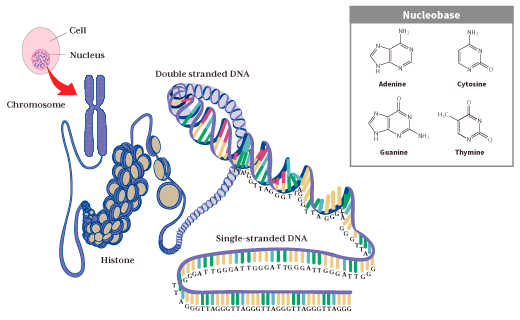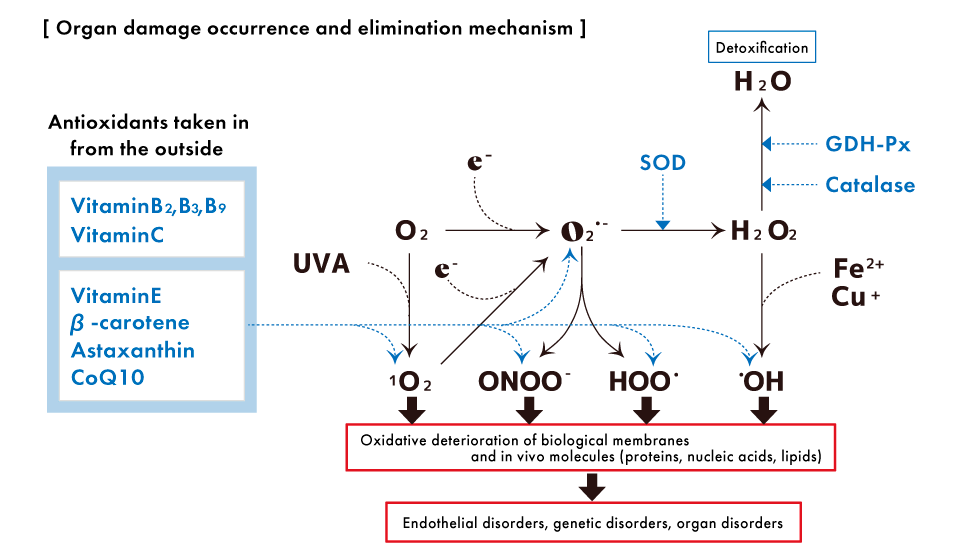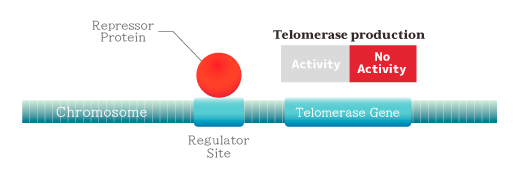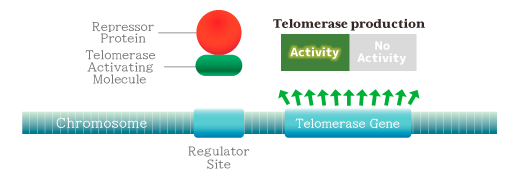Telomere
The Role of Telomeres
Telomeres are repetitive sequences “(5'-TTAGGG-3') n” that form at the ends of DNA to protect the gene (genetic information) that is our blueprint.

We humans are living organisms that are composed by repeating division and differentiation based on the genetic information of only one fertilized egg. In all cells (37.2 trillion), the gene inherited from the fertilized egg is inserted into the DNA that makes up the chromosome and is stored in the cell nucleus.
In order to maintain life, we humans repeat cell division every day, but the end of DNA (telomeres) is inevitably shortened by 20 to 200 base pairs in the replication process during cell division. (End-replication problem)
Therefore, when the telomere is shortened to its limit (division limit) so that genetic information is not compromised, scientific signals are sent, and cells irreversibly stop dividing (cell senescence) to protect important genetic information.
Accelerated Telomere Shortening
It is considered to be a de facto contributor to age-related diseases. There are inheritance and environmental factors that can determine an individual's telomere length, but in fact, environmental factors due to an individual's lifestyle have a significant impact.

Living an unhealthy lifestyle, such as obesity, smoking, lack of exercise, and mental stress causes free radicals and inflammation, which accelerates and shortens telomeres.
Recent studies have shown that in oxidative stress conditions where the balance between oxidative and antioxidant responses is disrupted due to environmental factors (such as environmental chemicals and UVA) and inflammation, excessively generated reactive oxygen species and peroxides can severely damage the G sequence of telomeres.
When the telomere length of human cells is calculated from the end replication problem, the theoretical maximum age of humans is considered to be 125 years. Historically, only one person has lived over the age of 120. In other words, no matter how healthy you eat or how much exercise you do, you cannot stop the basal level of telomere shortening.
This is because the average life expectancy for both men and women in Japan is 83.7 years, which indicates that not everyone lives to the highest age, but the speed of telomere shortening varies depending on each person's lifestyle.
Telomere shortening and Health
Whether it is the basal level shortening or accelerated shortening, if the telomere length becomes extremely short, our health will deteriorate rapidly as it falls off a cliff, resulting in multiple age-related diseases.
In the case of bedsores (pressure ulcers) seems to be caused by aging, which is a symptom caused by friction between the skin and sheets when sleeping in the same posture.
Originally, even if there are cells damaged by bedsores, it will heal because other cells divide as much as possible. However, when you are bedridden, the cycle of occurrence and healing repeats, and cell division is suppressed as much as possible because the telomeres of the cells around the bedsores become extremely short. This leads to the inability to heal the bedsores. Moreover, if the bedsore does not heal and is constantly wounded, it is likely to become infected and potentially life threatening.
Dr. Bill's Discovery

There are quite a lot of creatures in the world that do not show signs of aging. One of the creatures that do not show signs of aging are lobsters. In lobster cells, an enzyme called "telomerase" that extends telomeric repeat sequences has been found to be produced. This enzyme has only one function, which is when telomeres are shortened, it adds a base to the end of the chromosome. The only function of this enzyme is to add a base to the end of the chromosome as the telomere shortens.
In other words, living creatures with telomerase expressing cells will not show the signs of aging because the telomerase reverts the needle of the clock and turns back time.
Unfortunately, the cells in human body such as the bones, muscles, and organs do not express telomerase. However, among the 270 types of cells, only 3 types of cells (germ cells, cancer cells, stem cells) are known to express telomerase.
Initially, these three types of cells were thought to be unique with a special mechanism in human cells, but there was a researcher who believe that it should have the same mechanism in the 270 types of cells that have been produced by differentiation from one cell. That is Dr. Bill Andrews, also known as the “The Man Who Would Stop Time”.
❖ Part 1 Elucidation of why telomerase is not expressed― [Patent Number: US5583016, Issued 1996-12-10] ―

The DNA adjacent to the telomerase gene has one or more binding sites for the specific protein, and when the protein (repressor) attaches, the telomerase gene does not function, and as a result it becomes inactive and the cell no longer expresses telomerase.
❖ Part 2 Telomerase Activating Molecule― [Patent Number: US7199234, Issued 2007-04-03] ―

By controlling the repressor binding to the regulator with TAM, the telomerase expression gene can be turned on and the expression of telomerase can be induced.
